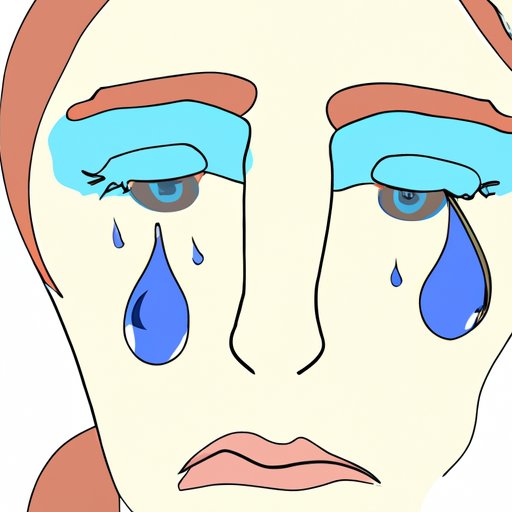Introduction
Crying is a natural and essential part of life. It’s a universal form of communication that transcends language barriers and connects us to others on an emotional level. But have you ever stopped to wonder what actually happens in your body when you cry? In this article, we’ll explore the science behind tears and the different types of tears we shed, as well as the physiological and emotional reasons why we cry.
Physiology of Crying: Exploring the Science Behind Tears
Tears are complex structures that are composed of three main components: water, proteins, and oils. The water component of tears is produced by the lacrimal gland, which is located just above the outer corner of each eye. The proteins and oils are secreted by other glands around the eyes, such as the meibomian glands and the goblet cells. Together, these components make up a tear film that helps keep the eyes lubricated and free from debris.
The neurochemical process behind crying is complex, involving several neurotransmitters that act on different parts of the brain. Neurotransmitters like serotonin, oxytocin, and endorphins all play a role in producing tears. Serotonin, for example, is a neurotransmitter that helps regulate mood and emotions. When serotonin levels are low, it can lead to feelings of sadness and depression, which can trigger crying. Oxytocin, on the other hand, helps promote feelings of trust and intimacy, which can also lead to tears. Finally, endorphins are responsible for the release of “feel-good” hormones that can cause us to cry due to intense joy or happiness.

Emotional and Biological Reasons for Why We Cry
From an evolutionary standpoint, crying has both biological and emotional purposes. On a biological level, tears help protect the eyes from irritants and flush out any debris that may have gotten into the eye. On an emotional level, tears can be used as a form of communication. They can convey a range of emotions, from sorrow and sadness to joy and happiness. Tears can also be used to express empathy, compassion, and understanding.
There are three main types of tears: basal tears, reflex tears, and emotional tears. Basal tears are the tears that our eyes produce on a regular basis to keep the eyes lubricated and healthy. Reflex tears are triggered by irritants like smoke and dust, and they help flush out the irritant from the eyes. Emotional tears are the tears that are produced in response to strong emotions, such as joy, sadness, anger, or grief.
The Benefits of Crying: How Shedding Tears Can Help You Heal
Crying is not only a normal part of life, but it can also be beneficial for our mental and physical health. Studies have shown that crying can help reduce stress levels by releasing tension and providing a sense of emotional release. It can also help strengthen relationships by allowing us to express our feelings and connect with others on a deeper level.
In addition to its emotional benefits, crying can also be beneficial for our physical health. Studies have found that crying can help boost the immune system and reduce inflammation in the body. Crying can also help reduce blood pressure, improve sleep quality, and even reduce pain.

Exploring the Different Types of Tears: Not All Tears Are Created Equal
As mentioned earlier, there are three main types of tears: basal tears, reflex tears, and emotional tears. Basal tears are the tears that our eyes produce on a regular basis to keep the eyes lubricated and healthy. Reflex tears are triggered by irritants like smoke and dust, and they help flush out the irritant from the eyes. Emotional tears are the tears that are produced in response to strong emotions, such as joy, sadness, anger, or grief. Each type of tear serves a different purpose, and understanding the differences between them can help us better understand the science behind crying.

Understanding the Role of Hormones in Crying: How Neurotransmitters Impact Our Tears
Neurotransmitters like serotonin, oxytocin, and endorphins all play a role in producing tears. Serotonin, for example, is a neurotransmitter that helps regulate mood and emotions. When serotonin levels are low, it can lead to feelings of sadness and depression, which can trigger crying. Oxytocin, on the other hand, helps promote feelings of trust and intimacy, which can also lead to tears. Finally, endorphins are responsible for the release of “feel-good” hormones that can cause us to cry due to intense joy or happiness.
Conclusion
Crying is a natural and essential part of life. It’s a universal form of communication that allows us to express our emotions and connect with others on an emotional level. But what exactly happens in our bodies when we cry? This article explored the science behind tears, from the anatomy of a tear to the role of hormones in producing tears. It also discussed the different types of tears and the emotional and biological reasons why we cry, as well as the potential benefits of crying for our mental and physical health. Understanding the science behind crying can help us better appreciate this complex and essential part of life.
(Note: Is this article not meeting your expectations? Do you have knowledge or insights to share? Unlock new opportunities and expand your reach by joining our authors team. Click Registration to join us and share your expertise with our readers.)
